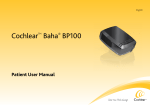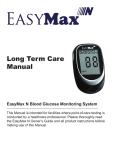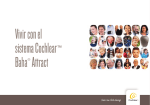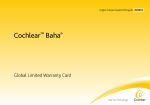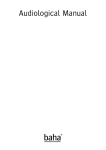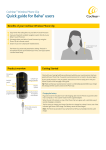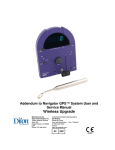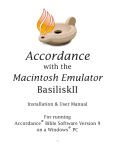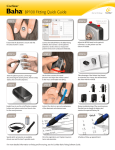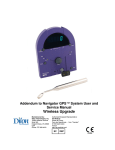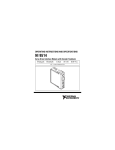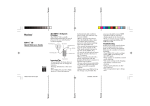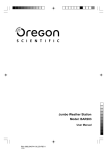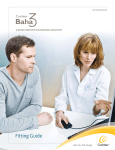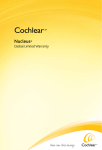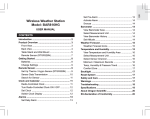Download Living with your Baha®
Transcript
Living with your Baha® For recipients DVD included 1 Contents 5 How to look after your Baha® – and yourself! 6 After surgery 6 Daily cleaning 7 Weekly cleaning 8 Attaching and removing your sound processor 9 Protecting your abutment 9 Attaching a safety line 10 Baha and children 10 What is a Baha Softband? 12 Twelve golden rules for handling your Baha sound processor 14 Using phones and other accessories 16 Quick guides to the sound processors 21 What to expect from your batteries 22 Troubleshooting 24 Aftercare Kit 25 About the DVD 26 How to look after your Baha – Quick Guide 2 3 How to look after your Baha® – and yourself! Your Baha® sound processor is a sophisticated hearing system full of delicate microelectronic components, so you must take care of it – and yourself! This brochure shows you what to do after the surgery and how to keep your Baha sound processor and the abutment in prime condition. The procedures outlined both here and in the accompanying DVD are so easy to follow, that they’ll soon become part of your daily routine. And the rewards will be well worth the effort! With a Baha system you’ll be able to hear and communicate with ease. 4 5 After surgery Weekly cleaning For the best result, you need to take care of the abutment to avoid any complications with the surrounding tissue. If the area has healed, the dressing and stitches will be removed 10–14 days after surgery. If not, the dressing may have to stay in place longer. Clean the inside of the abutment every week, with the abutment cleaning brush, as debris can also build up there. At home it is important to maintain good daily hygiene; for the first few weeks after the dressing has been removed, wash your hair carefully and use a strip of alcohol-free wet wipe to keep the skin around the abutment clean. Daily cleaning After the first few weeks you can start cleaning the outside of the abutment with the soft abutment cleaning brush provided. Aim the bristles at the side of the abutment, and remove any debris that might have built up around the base. You can do this while taking a bath or shower, using mild soap and plenty of warm water. When you have finished bathing, use a strip of alcohol-free wet wipe to make sure that all debris has been removed. 6 If you should experience soreness or inflammation, or if the abutment feels loose, contact your clinician or hearing care center. Otherwise, it’s a good idea to get checkups regularly. Remember: • Always rinse the abutment cleaning brush in mild soap and warm water and let it air dry. Change the brush every three months, or if you have had an infection. • If you have bilateral implants, use two separate cleaning brushes (one for each abutment), to avoid cross-contamination. • You can get new cleaning brushes from your hearing care center or order them from www.cochlear.com. 7 Attaching and removing your sound processor Your Baha sound processor is designed to snap onto the abutment. Simply attach it at a slight angle and tilt or rock it into place, taking care to keep your hair out of the way. The tilt technique reduces the pressure on the abutment and prevents any discomfort. Make sure you never push the sound processor straight in. To remove the sound processor again, lift your hair, slide a fingertip under it, and gently tilt it until it snaps off. Never pull it straight out. Protecting your abutment Whenever you are not wearing your Baha sound processor, you can protect the abutment using the press-on abutment cover provided with your sound processor. Wear it when sleeping, and when having hair treatments. During rough contact sports you can wear a sweatband over the abutment for additional protection. Attaching a safety line When taking part in activities where you risk losing your sound processor we recommend using the safety line provided. Insert the line into the attachment point and fasten it to your clothing. Note: The safety line should always be used when a Baha sound processor is worn by children. 8 9 Baha and children Children who use a Baha system need to observe the same routines as adults. Their parents/caregivers should teach them how to keep the abutment clean and the skin around it healthy. They should also be taught the importance of keeping their Baha sound processor safe – including using a safety line to avoid losing it. Note: In the US, the Baha implant is indicated for children aged five years and older. What is a Baha® Softband? Until children are ready for an implant they can wear their Baha sound processor on a colorful Baha Softband. This consists of an elastic headband with a plastic snap connector that holds the sound processor in place. To avoid any sore areas, this adjustable band can be turned, so the sound processor is not always in the same position. The Baha Softband enables a variety of listening opportunities. For example, in a car seat the sound processor can be worn on the forehead to maximize sound perception. Note: The Baha Softband contains natural rubber latex that might cause allergic reactions. 10 11 Twelve golden rules for handling your Baha® sound processor Your Baha sound processor contains very delicate components, so you should handle it with care – and never drop it! Follow these golden rules to keep your sound processor safe: 1. You can wear your Baha sound processor all day long – apart from when sleeping, bathing, showering, swimming or during rough contact sports. 2. When adjusting your sound processor, make sure your hands are clean to avoid getting the inside or outside of the casing dirty. 3. When taking part in activities where you could lose your sound processor, either remove it or use the safety line provided. 12 4. Your Baha sound processor is NOT waterproof. Never wear it in the shower or when swimming. In rainy conditions, use an umbrella. 5. If visiting or living in an area with high humidity, you can use a Dry Aid Kit (a bag or container that contains crystals that absorb residual moisture from your sound processor) to keep your sound processor in good working order. 7. Clean the external casing of your sound processor regularly with an AudioWipe®, and clean the snap with a small sound processor brush (both provided in the Aftercare Kit). 8. When using hair products like hairspray, always cover your Baha sound processor to avoid damaging the microphone or the casing. Alternatively, remove it entirely. 9. To avoid feedback (whistling), don’t let objects come too close to your Baha sound processor (e.g. a hat, hairbrush, phone, glasses etc.). 10. To store your Baha sound processor safely after use, remove the battery and place the sound processor in its case. 11. If you need an MRI scan, it is crucial to remove the sound processor beforehand. The implant and abutment can remain in place.* 12. When travelling, remove your Baha sound processor when going through security screening to avoid setting off metal detectors in places such as airports. An MRI/Security control instructions card is included with your sound processor, which provides information for airport personnel. 6. Your Baha sound processor cannot withstand extreme temperatures. So never leave it on the dashboard in your car in bright sunlight or expose it to any other kind of extreme treatment. *Arndt S, Kromeier J, Berlis A, Maier W, Laszig R, Aschendorff A. Imaging procedures after Bone-Anchored Hearing Aid implantation. The Laryngoscope 2007:117 13 Using phones and other accessories The best way to use telephones and cell phones with your Baha sound processor is to hold the phone receiver close to the microphone inlet of your sound processor rather than close to your ear. Don’t let your hand or the phone touch the sound processor, as this may cause it to whistle. When using Baha® Cordelle II, the phone receiver should be next to the microphone on the body-worn unit. Most landline telephones are “hearing aid compatible” i.e. they have a built-in telecoil. If you are a Baha BP100, Baha Divino or Baha Intenso user, you will need to attach the Baha Telecoil accessory to your sound processor and switch to the program for external equipment. For Baha® Cordelle II, the telecoil is built into the bodyworn unit, so all you need to do is switch to the Telecoil program. Telecoils, FM receivers, and Audio adapters are available as optional accessories for your sound processor. They are easy to order from your hearing care center or from www.cochlear.com. Note: FM receivers should be ordered from a hearing care center or the FM system manufacturer directly. FM Receivers An FM system makes listening easier in noisy environments, such as in classrooms. FM receivers can be specific in how they connect to your Baha sound processor; consult a hearing care specialist to determine the FM receiver that is best for you. Telecoil The Baha Telecoil accessory may help you hear better when using a phone or in buildings with loop facilities, such as churches, theaters, and airports. The Baha® Cordelle II has a built-in telecoil, so no external accessory is required. Audio adapter The Audio adapter allows direct input from computers, personal stereos, TVs, MP3 players and other external equipment. Always use the audio adapter to connect your Baha sound processor to any electrical or battery-operated equipment. * * * Only Cochlear products and accessories, or products and accessories approved by Cochlear, should be used with each other to ensure the warranty is maintained. *Choice of accessories may vary depending on your Baha sound processor model 14 15 Your quick guide to Cochlear™ Baha® BP100 u On/Off & Programme Selection Button: Use the middle button to conveniently switch on and off the BP100, and to switch between the programmes pre-set by your hearing care professional. v Volume down button Use this button to decrease the volume. w Volume up button u v w x v Use this button to increase the volume. x P lastic snap connector y Attachment point for the safety line y U B attery compartment door. Remove the door when changing battery. V Visual status indicators Orange for processors worn on the right side of the head Blue for processors worn on the left side of the head W D irect Audio Input: For connecting audio accessories. X Microphones Consult the Baha BP100 User Manual for more details. U V W X Note: Baha BP100 not shown in actual size 16 17 Your quick guide to Your quick guide to Baha Intenso™ Baha Divino ® u Volume control and On/Off button: Move the wheel up to turn your u Volume control and On/Off button: Move the wheel up to turn your sound processor on and to increase the volume. To decrease the volume and to turn your sound processor off, move the wheel down. sound processor on and to increase the volume. To decrease the volume and to turn your sound processor off, move the wheel down. v Program switch: v Program switch: Program 1 puts the microphone into omni-directional mode, where it will pick up sound from a 360° radius. Ideal for quiet surroundings. Program 2 activates the directional microphone. This will prioritize sounds coming from the front rather than from behind, which makes it easier to hear speech in noise. Note that in this program the electrical input is not activated, so any connected audio accessories will be muted. u v w Program 1 is the standard setting, suitable for most everyday situations. Program 2 is a comfort setting that may be useful in certain loud, adverse listening environments. Program E can be used when listening exclusively to input from an audio accessory, or as an instant mute, because it turns off the microphone. wD irect Audio Input: For connecting audio accessories. x Swing-out battery door: When changing the battery, remember to remove w D irect Audio Input: For connecting audio accessories. x Sliding battery door: When changing the battery, remember to remove the the plastic strip and make sure the plus-mark is facing upwards. Don’t force the door shut, as it could break. plastic strip and make sure the plus-mark is facing upwards. Don’t force the door shut, as it could break. Your sound processor will emit two beeps when the battery is low and needs to be changed. y u v w y Note: Never adjust the potentiometers y as this may void your warranty. Consult the Baha Divino User Manual for more detailed information. x Note: Never adjust the potentiometers y as this may void your warranty. Consult the Baha Intenso User Manual for more detailed information. Note: Baha Divino not shown in actual size. 18 x Note: Baha Intenso not shown in actual size. 19 Your quick guide to Baha® Cordelle II u Connector cable: Connect the straight plug to the head-worn unit and the angled plug to the body-worn unit. v Volume control and On/Off button: Move the wheel to turn your sound processor on or off and to increase or decrease the volume. w Tone switch: The tone switch controls the frequency response of the sound processor. It can be set in three different positions: N=Normal. Amplifies all frequencies equally. H=High frequency emphasis. Reduces low frequency sounds which may improve speech understanding, especially in background noise. L= Low frequency emphasis. May be especially useful during the first period after fitting as it allows you to gradually get used to high frequency sounds you have not heard for a long time. x Built-in telecoil y Direct Audio Input for connecting audio accessories U P rogram switch: M= Microphone, MT=Microphone and Telecoil, T=Telecoil V Flip-up battery cover: When changing the battery, remember to use 9V batteries only. Make sure the plus-mark on the battery is facing the plusmark on your body worn unit. Don’t force the door shut, as it could break. What to expect from your batteries u v w x y U W Which battery to use (type 13, 675 or 9V) will depend on which Baha sound processor you are using. Just remember that for the smaller type 13 and 675 batteries, the battery will begin to drain once you remove the plastic strip – even if the sound processor is not actually in use! The batteries delivered with your sound processor reflect Cochlear’s latest battery brand recommendation. There are a number of factors that affect battery life. Brand type is one factor; low temperatures and hourly use are others. The program and volume control settings – as well as the use of accessories such as FM equipment – can also affect the life of the battery. Be sure to use only new, high quality batteries as this gives the best sound performance. Testing type 13 and 675 batteries To test the battery, place it in the tester (provided in your Aftercare Kit) with the plus-mark facing upwards, and press it onto the metal band. The display screen will then indicate how much power is left. The more bars there are, the more power is left in the battery. V Note: Never adjust the potentiometers W as this may void your warranty. Consult the Baha® Cordelle II User Manual for more detailed information. Note: Baha® Cordelle II not shown in actual size. 20 21 Troubleshooting If you experience physical problems or any difficulty using your Baha system, follow the guidelines listed in the chart below. If this fails to help, please contact your hearing care center for further assistance. Problem Cause Possible Solution No sound/weak sound Weak or dead battery. Replace battery. Volume too low. Turn up volume. Feedback (whistling) Hat, glasses or other object in contact with sound processor. Check that the sound processor is not touching anything. Relocate or remove the object. Battery door in wrong position. Close battery door. Too high volume. Decrease volume. Weak battery. Replace battery. Loose abutment. Contact your hearing care specialist. Sound is distorted or intermittent 22 Problem Cause Possible Solution Sound processor does not work Sound processor is not turned on. Turn on sound processor. Battery door is not completely closed. Gently close the battery door completely. Dead battery. Replace battery. Battery inserted wrong way. Make sure battery is inserted correctly. Audio accessory program active and no accessory connected. Check program setting. Programming mode enabled. Remove and insert battery. Both indicators flashing Redness or soreness around the abutment Keep the abutment site completely clean, using the soft abutment cleaning brush and/or alcohol-free wet wipes. Apply a mild antibiotic cream/ointment (provided by clinic) if necessary. Contact your clinic or hearing care center if redness and/or soreness persists. 23 Aftercare Kit The following items are included in the Aftercare Kit: Living with your Baha® Brochure and DVD AudioWipes® Single pack wipe for cleaning the sound processor. Alcohol-free wet wipes Pack of 10 wipes for cleaning the abutment area. Battery tester Sound processor brush Black brush with hard bristles for cleaning the plastic snap. Abutment cleaning brush White brush with soft bristles for cleaning the abutment area. Mirror 24 To reorder supplies please visit www.cochlear.com Baha and Baha Divino are registered trademarks, and Baha Intenso is a trademark of Cochlear Bone Anchored Solutions AB. Cochlear and the elliptical logo are trademarks of Cochlear Limited. © 2009 Cochlear Bone Anchored Solutions. All rights reserved. APR09 About the DVD • • • • • • • Using your sound processor Taking care of your abutment Taking care of your sound processor Audio accessories and telephones Testing your sound processor Baha® Softband When to visit the clinic 25 How to look after your Baha® Place the sticker below on your bathroom mirror as a reminder to maintain good daily hygiene for the abutment, skin in the surrounding tissue area and sound processor. 1. After surgery, use a strip of alcohol-free wet wipe to keep the skin around the abutment clean. 2. Clean the outside of the abutment with the abutment cleaning brush daily. 3. Clean the inside of the abutment with the abutment cleaning brush weekly. 4. Wipe the sound processor using an alcoholfree AudioWipe®. 5. Clean the snap connector using the black sound processor brush. Living with your Baha® Baha and Baha Divino are registered trademarks, and Baha Intenso is a trademark of Cochlear Bone Anchored Solutions AB. Cochlear and the elliptical logo are trademarks of Cochlear Limited. © 2009 Cochlear Bone Anchored Solutions. All rights reserved. JUL09 26 27 Manufacturer: Cochlear Bone Anchored Solutions AB Konstruktionsvägen 14, SE-435 33 Mölnlycke, Sweden Tel: +46 31 792 44 00 Fax: +46 31 792 46 95 Regional offices: Cochlear Americas 13059 E. Peakview Avenue, Centennial, CO 80111, USA Tel: +1 303 790 9010 Fax: +1 303 792 9025 Cochlear AG European Headquarters, Peter Merian-Weg 4, CH-4052 Basel, Switzerland Tel: +41 61 205 0404 Fax: +41 61 205 0405 Cochlear Ltd (ABN 96 002 618 073) 14 Mars Road, Lane Cove NSW 2066, Australia Tel: +61 2 9428 6555 Fax: +61 2 9428 6352 Local offices: Cochlear Benelux NV Schaliënhoevedreef 20 i, B-2800 Mechelen, Belgium Tel: +32 15 79 55 77 Fax: +32 15 79 55 70 Cochlear Canada Inc 2500-120 Adelaide Street West, Toronto, ON M5H 1T1, Canada Tel: +1 416 972 5082 Fax: +1 416 972 5083 Cochlear (HK) Ltd Beijing Representative Office, Unit 2205 - 2207, Tower B, 91 Jianguo Road, Chaoyang District, Beijing 1000022 P.R. China Tel: +86 10 8599 9924 Fax: +86 10 8599 9804 Cochlear France S.A.S. Route de l'Orme aux Merisiers, Z.I. Les Algorithmes - Bât Homère, F-91190 St Aubin, France Tel: +33 811 111 993 Fax: +33 160 196 499 Cochlear Deutschland GmbH & Co. KG Karl-Wiechert-Allee 76A, D-30625 Hannover, Germany Tel: +49 511 542 770 Fax: +49 511 542 7770 Cochlear (HK) Ltd Room 1810, Hopewell Centre, 183 Queen's Road East, Wan Chai, Hong Kong Tel: +852 2530 5773 Fax: +852 2530 5183 Cochlear Italia SRL Via Augusto Murri, 45/L, I-40137 Bologna, Italy Tel: +39 051 741 9811 Fax: +39 051 392 062 Nihon Cochlear Co Ltd Ochanomizu-Motomachi Bldg, 2-3-7 Hongo, Bunkyo-Ku, Tokyo 113-0033, Japan Tel: +81 3 3817 0241 Fax: +81 3 3817 0245 Cochlear Korea Ltd 5F, Seong San BD, 1689-5, Seocho-dong, Seocho-gu, Seoul, Korea Tel: +82 2 533 4450 Fax: +82 2 533 8408 Cochlear Ltd (Singapore Branch), 6 Sin Ming Road, #01-16 Sin Ming Plaza Tower 2, Singapore 575585 Tel: +65 6553 3814 Fax: +65 6451 4105 Cochlear Nordic AB Konstruktionsvägen 14, SE-435 33 Mölnlycke, Sweden Tel: +46 31 335 14 61 Fax: +46 31 335 14 60 Cochlear Tıbbi Cihazlar ve Sağlık Hizmetleri Ltd. Sti., Cubuklu Mah. Bogazici Cad., Bogazici Plaza No:6/1, Kavacik 34805 Beykoz-Istanbul, Turkey Tel: +90 216 538 5900 Fax: +90 216 538 5919 Cochlear Europe Ltd 9 Weybridge Business Park, Addlestone Road, Addlestone, Surrey KT15 2UF, United Kingdom Tel: +44 1932 87 1500 Fax: +44 1932 87 1526 www.cochlear.com Baha and Baha Divino are registered trademarks, and Baha Intenso is a trademark of Cochlear Bone Anchored Solutions AB. Cochlear and the elliptical logo are trademarks of Cochlear Limited. AudioWipes is a registered trademark of Oaktree Products Inc. © 2009 Cochlear Bone Anchored Solutions. All rights reserved. JUN09. Printed in Sweden. E81254A















